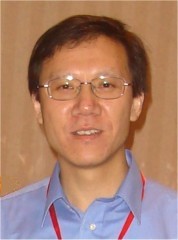 |
Short Bio:
Hujun Yin received BEng and MSc degrees from Southeast University (formerly Nanjing Institute of Technology) in 1983 and 1986 respectively, and PhD degree from University of York in 1996. He jointed the University of Manchester (UMIST before the merge) in 1996 as a Post-Doc Research Associate. He was appointed Lecturer in 1998 and became a Senior Lecturer in 2003. His other previous employments include Assistant Lecturer and Lecturer at Tongji University, Shanghai from 1986 till 1991.
He is a senior member of the IEEE and a member of the EPSRC Peer Review College.
He gave a plenary talk to HAIS 2008. He was a Tutorial Speaker at WCCI 2008 (Title: Nonlinear Dimensionality Reduction and Data Visualisation). Chair of Special Session on Principal Manifolds and Data Visualisation at IJCNN 2007. An organiser of Biologically Inspired Information Fusion Workshop, Surrey, 22-23 August 2006. A talk on "The Self-Organising Maps for Data Visualisation and Manifold Mapping" to Workshop on Principal Manifolds, Leicester, 24-26 August 2006.
He was an Associate Editor of IEEE Transactions on Neural Networks (2006-2009) and has been a member of Editorial Board of International Journal of Neural Systems (since 2005).
|
| |
Talk: Face Recognition and Challenges.
Among various biometric methods, facial image based has certain advantages such as nonintrusive, easily deplorable and highly accurate. Face recognition has found increased applications in security, surveillance, authentication, e-commerce and social networking. Most existing facial recognition methods are appearance-based and reply on facial images for training and recognition. There also exist methods for extracting geometric features of facial images and local facial features for improving recognition performance and/or reducing processing time. This talk gives an introduction to face recognition and its fundamental methods, implementations and applications. The talk will also discuss the challenges in implementation and practical systems.
Face recognition can be cast as a pattern classification and machine learning problem: given a set of facial images labeled with subjects' identities, a classifier is developed or trained; so that when a novel face image from the same group of people (or not) is presented. That is, we seek to identify it from the database. Usually face recognition process involves three steps: face detection, feature extraction and classification. In the first step, the face is detected and located in the image. In the second step, a collection or combination of descriptive measurements or features are extracted from each image. In the third step, a classifier is trained on known samples to assign to each feature vector with subject's identity. Advanced feature extraction methods such as local binary pattern (LBP) and active shape will also be discussed, along with the roles of advanced feature selection or dimensionality reduction methods and advanced classification techniques such as Support Vector Machines (SVM) or kernel methods.
Then the talk will discuss the challenges facing various aspects of face recognition systems. Lighting effect is far by the largest problem in face recognition or many image processing and computer vision. Solutions from homomorphic filtering to low dimensional representation (e.g. spherical harmonics and manifolds) will be explained. Other challenges include robust or invariant to pose, expression and partial occlusion. Increasing popularity and imaging power of mobile devices such as smartphones and tablets has prompted development of numerous new applications on them. Implementing face recognition onto mobile devices poses a new challenge as the application environment is subject to various uncertainties such as lighting, background and viewing angles, as well as reduced computational power.
|





